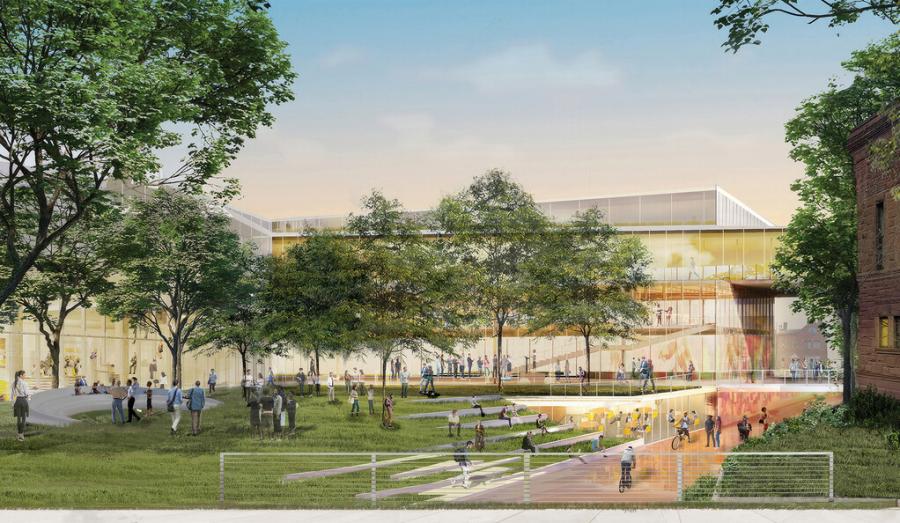Yale University announced plans for a historic series of infrastructure investments that would transform the face and trajectory of its School of Engineering & Applied Science (SEAS) and advance the university’s strategy for hastening engineering, science, and technology breakthroughs. (Rendering courtesy of Yale University)
Over the next 10 to 15 years, Yale University will expand its School of Engineering & Applied Science (SEAS) campus presence through a construction overhaul of lower Hillhouse Avenue in New Haven, Conn.
The prestigious university intends to launch several major construction projects in the Hillhouse area, reported Yale News, the nation's oldest college daily newspaper, on Feb. 26. Yale Provost Scott Strobel and SEAS Dean Jeffrey Brock revealed the school's plans to the university's engineering faculty in a recent meeting.
The project will take place on sites already owned and occupied by Yale and will include the construction of a new SEAS quadrangle on the east side of Hillhouse Avenue. To accommodate the new facilities, the university will demolish Mason Laboratory, Helen Hadley Hall, and the southern portion of Dunham Laboratory. The scheme also will reorganize SEAS faculty offices by research focus rather than department.
The news follows Yale's announcement last year to establish SEAS as an autonomous faculty body with 30 new faculty members. The expansion, which will raise the SEAS faculty size to 122, chiefly aims to add faculty in computer science — the most popular major among engineering undergraduates and an area that has historically lacked institutional support — and materials science.
"We envision something that reflects both the history and heritage of Yale's campus but also makes a bold statement about modern, forward-looking engineering for the future," Brock told the News. "We'll see spaces that are organized around new centers of activity, initiatives and research directions, in addition to things like collaborative spaces and [room] for innovation, makerspaces and entrepreneurship."
Brock said the plan was guided by the 2021 SEAS strategic vision report, which recommended that the university organize campus space by "research and teaching priorities rather than by department." Yale has taken this organizational approach in several other recent facilities projects, including Kline Tower and 100 College Street.
The benefits of reorganization extend beyond facilitating research, biomedical engineering professor James Duncan told the News, in that it may also help SEAS recruit new faculty members.
"The construction/renovation plans will create new and updated space that will greatly enhance both our teaching and our research activities," Duncan wrote in email to the News. "As noted in the announcement, the new lower Hillhouse space will be organized around research priorities, which will help us when recruiting new faculty and working with colleagues across SEAS."
New Construction, Renovations Planned
A prominent feature of the plan is the new SEAS quad, which will be constructed on the eastern side of lower Hillhouse Avenue, where 17 Hillhouse Ave., Mason Laboratory and Helen Hadley Hall now stand. The quad, Strobel explained, will be open to Hillhouse Avenue and ringed by modern lab spaces.
The building project also seeks to modernize existing engineering buildings, including the Becton Center, Dunham Laboratory and Arthur K. Watson Hall, he added. Many such buildings are over a century old and were not designed for engineering teaching or research. For example, 17 Hillhouse Ave. was built to be Yale's health center.
Strobel said that the choice to build engineering facilities in the heart of the campus was not an accident. Rather, it reflects Yale's plan to make SEAS "the engineering school that's most integrated with the rest of its university."
The first step of the plan, which will begin this summer, is to convert Kirtland Hall into flexible classroom space to accommodate classes that would have taken place in the buildings being renovated or demolished. The structure currently houses the psychology department, which will move to 100 College Street.
Next will be to design two new buildings: one at the corner of Trumbull Street and Hillhouse Avenue, the other at the current site of Helen Hadley Hall. Strobel said these projects are "probably still a year or two out."
In addition to the lower Hillhouse construction, the university will simultaneously begin construction of the new physical sciences and engineering building at the north end of campus.
"I would say the motivation is not merely to accommodate growth," Brock told the campus news source. "We've seen a huge increase in [student] demand [for engineering], and, as we've moved to accommodate that, we've realized that we really need state-of-the-art facilities to recruit top faculty and sort of signal to the world that Yale is ready to lead in this area."
He noted that facilities are absolutely central to the recruiting process.
"Being able to bring in top faculty from other institutions or … faculty that are new PhDs requires that we offer them first-rate [labs] that are integrated with the campus."
Students and faculty in Yale's computer science program have long called for upgrades to the "outdated" Arthur K. Watson Hall, which currently houses the department. Several professors have said that the department's sub-par facilities greatly impact its ability to attract world-class researchers and faculty members.
New Quad Could Help Address Broad Challenges
Yale's decision to build the new School of Engineering & Applied Science quad will, it claimed, aid the university's "broad effort to address grand challenges of the 21st century," like climate change and sustainable development.
"To support a generation of researchers focused on mitigating climate change, the growth of the SEAS department[s] must align with more rigorous sustainability goals and designs for infrastructural development," Saachi Grewal, an applied physics student, told the Yale News.
Grewal also noted that as a researcher on campus, she was excited to envision the increased capacity that the investment in SEAS could grant campus labs.
Today's top stories











